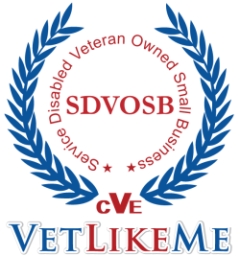Alert from the American Small Business League
(October 23, 2014) – Lloyd Chapman is a nationally-known advocate for small businesses that primarily do business with the federal government. He is a contributor to VetLikeMe.
Hi Hardy, Thanks for your time today! Per our conversation, below is the information that we’re sending out to create awareness about this harmful new policy – The American Small Business League (ASBL) is spreading awareness about the SBA’s recently proposed new policy that will devastate small IT firms that make over $27.5 million. According to this new proposed policy, if you are a small business IT reseller and you use NAICS code 541519 and have revenues over $27.5 million, you will no longer be considered a small business.
At the same time, Fortune 500 companies like Lockheed Martin, Boeing and Raytheon are still receiving small business contracts and credit towards their small business goals. WHAT ASBL IS DOING: The American Small Business League is working with our legal team to obtain an injunction to stop this policy and we need your help.
- With your help and the support of thousands of other small businesses, we would also like to hire a public relations firm to get this story out nationally to help keep companies like yours doing business with the government and from being bumped out of your small business status.
WHAT YOU CAN DO: We encourage everyone to contact their Congressman and Senators and oppose the SBA’s new policy and to also put a comment on the Federal Register’s website stating your opposition and explain why this will hurt your company. SBA claimed to finally hit their yearly small business goal. However, every year small business contracts are ending up in the hands of Fortune 500 companies and thousands of other large businesses and being counted towards the SBA’s goals.
 In fact, the SBA Office of Inspector General (OIG) just reported over $400 million in small business awards went to ineligible firms and over $1.5 billion went to companies that were no longer in the 8(a) or HUBZone programs. The American Small Business League has been fighting to uncover fraud for years.
In fact, the SBA Office of Inspector General (OIG) just reported over $400 million in small business awards went to ineligible firms and over $1.5 billion went to companies that were no longer in the 8(a) or HUBZone programs. The American Small Business League has been fighting to uncover fraud for years.
Our President, Lloyd Chapman, has a track record of working to protect our nation’s 28 million small businesses. Lloyd was recently recognized by American Express as one of the four biggest voices for small businesses in Washington alongside SBA Administrator Maria Contreras-Sweet. Listen here to his most recent radio appearances on The Dan Cofall Show and The Blaze Morning Show with Doc Thompson.
_________________________________________
CVE’s Unwritten (But Very Real) New Requirements
by Sarah Schauerte
_______________
If a business wants to do set-aside work with the VA, it must be listed in the Center for Verification and Evaluation’s (CVE) VetBiz registry. This means inputting business information into an online portal, uploading a wide range of documents, and answering probing questions designed to determine whether the business is truly “owned” and “controlled” by a veteran.
Lately, I’ve noticed the process has seemed more messy than usual, and I believe a big part of this comes down to the additional documents the CVE has been requesting. While it appears the CVE is now requesting these documents fairly consistently, the problem is (with one exception) these are not listed in its list of required documents posted on its website: 1099 Information – Before now, the CVE only asked for information about “employees” of a business – those for whom W2s are filed. Now, however, the CVE asks for a “Federal 1099 Report,” which is a summary report of monies paid to 1099 consultants.
There are two problems with requesting this information. The first is it doesn’t tell the CVE anything – the federal form (IRS Form 1096) requested doesn’t break down who was paid what, which means that if the total is more than the amount paid to the veteran, the CVE will come back and request more information. This is because the CVE asks for this in order to determine that the veteran is the highest paid, which leads to the second problem. The regulation the CVE cites to – 38 CFR 74.4(g) – imposes limits on compensation only on those involved in the management of the business. If the 1099 consultant doesn’t fit that role – and they probably don’t given they’re a 1099 consultant – this information isn’t even relevant to the “highest compensated” requirement.
Certificate of Good Standing – The CVE is now asking for certificates of good standing from the states where a business is registered (either incorporated/organized or registered as a foreign entity). This is also required in 8(a) BD applications, so it’s not like this requirement is particularly onerous. However, because it might take a few weeks to obtain a Certificate of Good Standing from a state that doesn’t transmit them electronically, a business risks having to withdraw its application if the CVE requests a Certificate and the business can’t obtain it in time. Rent Checks – This is on the CVE’s list of required documents now, but it’s worth mentioning because it’s new.
The CVE now wants the last three rent checks for the business. This is presumably to verify the address where the business is actually operating, as well as to make sure the veteran is signing the checks. However, this information should be clear on the business license; and it’s not unusual for the Comptroller or other employee to sign the checks, leading to the need for additional clarification. Whether you’re going through verification or reverification, one of the things I’ve always reiterated is the need to be prepared. It is, however, hard to be prepared when you aren’t told everything you need. I hope this blog post saves you some time (and Advils!) as you navigate through the process.
*Did you find this blog informative? If so, sign up for my weekly legal blog on veterans issues at LegalMeetsPractical.com. Remember to click the link sent to your email to activate your subscription!

____________________________________________
Stone 10/22/2014
Five Lessons the Special Forces taught me about Business
October 23, 2014 Filed Under: News, VetLikeMe Weekly
… by Michael I. Kaplan
__________
Oct 10 2014 Last month I had the pleasure of speaking at a Wounded Warrior Project workshop on business and entrepreneurship in Tampa, Florida. During our question and answer session a young veteran made a statement that I found incredibly interesting and served as the inspiration for this article.
The gentleman – a US Army veteran who served as a sniper instructor and team leader – prefaced his question about resume writing with the following statement: “I was an infantry team leader and a sniper instructor, which doesn’t have any real value in the corporate world. So, I wanted to know if you could tell me how …?”
Stop right there. I vehemently disagree. Veterans entering the civilian workforce have to understand that their resumes actually reflect much more than hard skills and transferable skills; they have to reflect and promote the benefits of life experiences that will prove to be “mission critical” to prospective employers. Further, those benefits need to be communicated to prospective employers effectively.
More important, it’s our responsibility as military veterans to educate Corporate America to this fact as well. Not sometime in the future, but now. My message to civilian employers and aspiring veteran job-seekers is rather straightforward. While you may not immediately see a direct correlation between military training and the job in question, be advised that those experiences have created a mindset that’s directly relevant to succeeding in any business environment. Consider the 5 following lessons that prove this fact to be true.
- Planning is essential, but contingency plans are critical. In the military we rely on the Operation Order to guide or missions, hoping that the intelligence data our mission is based on is accurate and timely. We plan, we train and we prepare to execute the mission flawlessly. We’re inserted into the area of operation and beginning our movement to the target when our team leader suddenly exclaims, “WAIT … there’s not supposed to be a river here.”
When veterans come face-to-face with Murphy’s Law, they can adapt and overcome. They have contingency plans that allow them to think and react quickly. They didn’t get this ability from reading a book.
- 360-degree awareness gets the team home safely. The ability to be completely aware in hostile and non-permissive environments saves lives in combat situations. There’s no room for “I should have seen that coming” when it comes to explosive devices or rifle barrels protruding from windows in buildings.
Veterans with this experience have command over their business environment. They walk into offices and immediately scan the walls for informative plaques, and guide introductory conversations after noticing a lapel pin or a class ring on the hand they shook. They seal deals and get the team back successfully.
- Wait for the best shot, not the perfect shot. In sniper school we’re trained to patiently wait for our shot, unaffected by our environment. When the target presents itself, we act: range it, dope it, scope it and pull the trigger. We’d like a perfect shot, but we know that if we hold the scope on target too long muscle fatigue sets in and our scope begins a figure-8 wobble. When that happens, we missed our opportunity.
Veterans in the civilian workforce hope for a perfect outcome, but they’re not afraid to execute when ready and make course corrections along the way if needed. They don’t suffer from “paralysis by analysis,” and they certainly don’t succumb to “deer in the headlights” syndrome. They’re doers.
- Know when to advance, stand down and retreat. In our modern age of special operations warfare, small teams of highly specialized personnel with a high degree of autonomy are tasked with successfully executing tactical operations with the hope of having a strategic impact. We’ve been trained to exercise good judgment: we know when it’s right to execute, and we know there are times when the situation requires us to quietly stand down and retreat unnoticed.
Veterans in the civilian workforce don’t let pride and ego override this reality. When a meeting is going badly they know how to gracefully end the conversation and exit with dignity. When contract negotiations stall, they have the judgment to know when to maneuver to a successful conclusion and when to stand down for another opportunity. They didn’t obtain this critical life skill in a classroom.
- Individuals are strong, but teams are powerful. Special Operations personnel are the most well-trained and highly lethal individuals on this planet. We also know that we have to sleep, and in a hostile environment that would be impossible were it not for the other members of the team remaining awake and alert. When we execute our missions, we’re as focused on the safety of the team members to our right and left as we are on the mission in front of us. As a cohesive team, the effectiveness of our combined individual skills increases exponentially.
Veterans in the civilian workforce live by the mantra “first my mission, then my men, then myself” and know the powerful capabilities of a cohesive team. They derive satisfaction from their individual accomplishments but realize their potential increases exponentially as a unit. They despise self-absorb, back-stabbing sycophants. If you’ve never heard the term “Blue Falcon,” I encourage you to look it up now. In summary, if I handed you my resume you’d never see these skills listed … but they’re there. You may not believe Special Forces training is relevant to the sales job you advertised … but it is. The next time a military veteran applies for a position with your company, look beyond the resume and the rifle. What you’ll discover about our military veterans will pleasantly surprise you.
_____________________________________

Michael Kaplan is the founder and CEO of Phase 2 Advantage, a consulting company that provides entrepreneurship and business management training for military and academic organizations. His most recent book, The Prior-Service Entrepreneur: Providing Military Veterans with the Competitive Skills to Start a Successful Business, has earned a 5-star rating on Amazon and is currently used as a course textbook in numerous business and entrepreneurship training programs throughout the United States.
https://www.linkedin.com/profile/view?id=235683674&authType=name&authToken=Bp2R&ref=CONTENT&trk=mp-ph-pn Stone 10/22/2014
_________________________________________
Federal Court: VA CVE Improperly Disqualified Eligible SDVOSB
By Steven J. Koprince & Amanda M. Wilwert
________
SDVOSBs—and basic fairness and common sense—were big winners in a recent decision issued by the U.S. Court of Federal Claims. In its decision, the Court held that the VA’s Center for Verification and Evaluation (CVE) violated the law when it disqualified a SDVOSB, without giving the SDVOSB the opportunity to contest the reasons for the disqualification. In a decision reminiscent of last year’s landmark Miles Construction case, the Court then held that the CVE’s substantive reasons for the disqualification were arbitrary and unreasonable.
In AmBuild Company, LLC v. United States, No. 14-786C (Oct. 10, 2014), AmBuild was the apparent lowest-cost bidder on a VA SDVOSB set-aside solicitation. The second-lowest bidder, Welch C onstruction Inc., filed a protest challenging AmBuild’s SDVOSB status. Welch contended that AmBuild was not controlled by a service-disabled veteran and that AmBuild exceeded the applicable size standard. The U.S. Small Business Administration, which has jurisdiction over size issues, reviewed Welch’s small business allegation and determined it to be unfounded.
onstruction Inc., filed a protest challenging AmBuild’s SDVOSB status. Welch contended that AmBuild was not controlled by a service-disabled veteran and that AmBuild exceeded the applicable size standard. The U.S. Small Business Administration, which has jurisdiction over size issues, reviewed Welch’s small business allegation and determined it to be unfounded.
The CVE proceeded to separately analyze Welch’s allegation regarding SDV control. Although neither Welch nor the VA’s Contracting Officer had raised any allegations regarding AmBuild’s compliance with the SDVOSB ownership regulations, the CVE examined AmBuild’s Operating Agreement and determined that AmBuild did not meet the requirements for unconditional ownership. Specifically, the CVE focused on Article 1 of AmBuild’s 2014 Operating Agreement which provides for the involuntary withdrawal of a member upon the occurrence of certain events.
The CVE particularly relied on two clauses in Article I. First, Clause iii providing for involuntary withdrawal in the event a “Member is adjudged bankrupt or insolvent or there is entered against the Member an order for relief in any bankruptcy or insolvency proceedings.” Second, Clause ix providing for the transfer of ownership “o n account of a court order or otherwise by operation of law.” The CVE found that Article I violated the SDVOSB ownership requirements under 38 C.F.R. § 74.3(b) because, in the CVE’s view the “Involuntary Withdrawal” provision of that agreement “include[s] numerous conditions, that are outside of [service disabled veteran owner’s] control, which would force [the owner] to sell his ownership interest to the [c]ompany or remaining [m]embers.”
n account of a court order or otherwise by operation of law.” The CVE found that Article I violated the SDVOSB ownership requirements under 38 C.F.R. § 74.3(b) because, in the CVE’s view the “Involuntary Withdrawal” provision of that agreement “include[s] numerous conditions, that are outside of [service disabled veteran owner’s] control, which would force [the owner] to sell his ownership interest to the [c]ompany or remaining [m]embers.”
During the protest process, AmBuild was never informed that CVE was investigating an additional issue, and was not given any opportunity to respond to the CVE’s concerns regarding the ownership provision. AmBuild first learned of the CVE’s Operating Agreement concern when AmBuild received a CVE determination declaring AmBuild to be ineligible for award of the contract. AmBuild appealed the CVE’s decision to the Executive Director of VA’s Office of Small and Disadvantaged Business Utilization (“OSDBU”), which denied the appeal. AmBuild then filed suit in the Court, alleging the VA’s disqualification of AmBuild violated procedural due process and was arbitrary and capricious. The Court first addressed the CVE’s failure to notify AmBuild of the new issue under investigation.
The court wrote that although the CVE has the discretion to expand a SDVOSB investigation beyond the issues raised by the protester or the contracting officer, the SDVOSB must be given notice and the proper opportunity to respond to the inquiry. Accordingly, the VA’s termination of AmBuild’s SDVOSB status without notification or the opportunity to respond violated the “minimal requirements” for an informal adjudication. Next, the Court turned to the substantive reason the agency disqualified AmBuild. The Court examined AmBuild’s 2014 Operating Agreement and determined that the “Involuntary Withdrawal” provisions appeared to be boilerplate clauses taken from a standard limited liability company operating agreement. The Court wrote that, contrary to the VA’s arguments, there are certain standard commercial arrangements regarding bankruptcy, receivership, and transfer by the court or operation of the law that do not abridge the ownership requirement of a SDVOSB.
For example, the provision for an involuntary withdrawal in the event that a member is adjudicated bankrupt is consistent with Federal bankruptcy law because personal bankruptcy creates an estate comprised of the debtor’s property which includes his or her ownership rights in a limited liability company. The Court held that the clauses of AmBuild’s operating agreement were not inconsistent with the ownership requirements of SDVOSB regulations because those clauses deal with “normal commercial practices” and therefore did not “affect the unconditional nature of ownership” within the meaning of 38 C.F.R. § 74.3(b).
The Court ruled in AmBuild’s favor and issued an order requiring the VA to recertify AmBuild as a SDVOSB. The Court’s decision in AmBuild is an important victory not just for AmBuild, but for all SDVOSBs. As the Court held, if the CVE questions a SDVOSB’s eligibility as part of a protest, the CVE must give the SDVOSB the opportunity to understand the CVE’s specific concerns and respond to those concerns. Moreover, (as was the case in Miles Construction), the CVE’s interpretation of its regulations should not unnecessarily prohibit “normal commercial practices,” such as the provisions in AmBuild’s operating agreement. Hopefully, the CVE will take these lessons to heart.

Sanders Reacts to Social Security Adjustment
Editor’s note:I am a Disabled American Veteran…a 100% disabled American Veteran…I find this shocking and abhorrent to the principles that make this country great–that Paul Ryan (R-WI)- Chairman of the House Appropriations Committee – could revisit this treacherous bill fits right in with his personality–a guy who never sweat blood for his country. BURLINGTON, Vt., Oct. 22 – U.S. Sen. Bernie Sanders (I-Vt.), chairman of the Senate Committee on Veterans’ Affairs, said he is “disappointed” by today’s announcement of only a 1.7 percent increase in the cost-of-living adjustment for Social Security beneficiaries and disabled veterans.“At a time when the prices of prescription drugs and electricity are skyrocketing, I am disappointed that seniors and disabled veterans will only be getting a 1.7 percent increase next year,” said Sanders. “This is the third year in a row that the cost-of-living adjustment will be less than 2 percent.” The cost-of-living adjustment is one of the smallest increases since the automatic annual adjustments were adopted in 1975. (There was no increase in benefits in 2010 or 2011.) “As bad as that is, it could be a lot worse. Many Republicans believe that these cost-of-living adjustments are too generous. They want to significantly cut Social Security by enacting a so-called chained CPI,” said Sanders. “That would be a disaster not only for the 58 million Americans who rely on Social Security, but for nearly 4 million disabled veterans. Instead of cutting Social Security, we need to expand it by creating an elderly CPI that accurately measures the spending patterns of seniors.” Under the chained CPI, the average senior who retires at age 65 would see their Social Security benefits cut by about $658 a year when they reach 75 and by about $1,100 a year once they turn 85. At the beginning of 2014, the average Social Security benefit for a retired worker was $1,294 a month. The chained CPI would also substantially cut the VA benefits of nearly 4 million veterans. The largest cuts would impact young, permanently disabled veterans who were seriously wounded in combat. It would also impact more than 350,000 survivors who receive service-connected death benefits. Veterans who started receiving VA disability benefits at age 30 would have their benefits reduced by $1,425 at age 45, $2,341 at age 55 and $3,231 at age 65. Sanders is chairman of the Senate Committee on Veterans’ Affairs, the founder of the Senate’s Defend Social Security Caucus and has worked with virtually all major veterans organizations to oppose the chained CPI. |
|||
______________________________________________
Letter to VA Contracting from…
__________
To VA Leadership, I have been requesting a debrief from your folks at the Cemetery Division regarding the award to the FRAUD xxxxx for almost a month and a half and finally got a call from xxx xxxxx who has no idea about anything. However as you should recall I predicted I would simply get a “formal letter” just like the dozen others you send me and Mr. xxxxxx just confirmed. Of course VA can give this contract to a company who doesn’t even list the NAICS code as qualified to be awarded but of course you know that after I just told Mr. xxxxxx.

VA awarded this 665k project for 50k more than I bid on a LTA proposal but this is only a small drop in the bucket since we have listed millions VA has wasted in awarding to just xxx over the past month including over 250k when Glen/Mar was the lower bidder on a 2.4 million dollar award to xxx. All total your command has awarded xxx over 50 million in Sept and this company is not just a complete fraud, front company and Rent-a-Vet…your own hands have posted their “hidden partners” as suppliers to contract with “…xxx fab con A.K.A. xxxxxxxxxxxx POC xxxxxx.” The xxxxxx family companies have over 100m is businesses but you folk just keep awarding to them. Mr. xxxxxx was kind enough to let me know there is no information about a “real” review of my proposal then said he has no information.
The good news is we have a couple trials scheduled with VA over the “normal” treatment of the SDV program or the “standard” treatment by VA officials and you all know what I am talking about. Even better is the media finally is tracking this and with our new SEC of VA we believe he will listen to the truth. You don’t just get to sweep me under the VA blanket of “hope he goes away” because it ain’t happening…Master Chief Hesser taught me to never let the bastards grind me down and quit.
Last, Mr. xxxxxx, just like every single VA contracting person I have dealt with said the same thing when asked about looking at any company VA awards to and I quote “if they are in the CVE we award”. When asked if they look for all the other requirements he said “of course not, all we need is CVE to award”. This classic lack of effort by VA is magical. Your folks refuse to look at NAICS codes, size standards, affiliations, ownership or change in status, ability to self-perform the work; Is the “sub” doing everything, can they even pay to get the job started…is this a front company? VA is simply the laziest entity I have ever encountered…
Enjoy the day folks…our Veterans are dying, starving, homeless and hopeless but you guy’s give a massive fraud 50m and I’ll bet you sleep well tonight.
Veterans Hire Veterans and 22 Veterans a day commit suicide and you folks are supposed to be the ones making sure real vets get a fighting chance. You are not doing your jobs and while I have no money, I will never run out of fight or forget the oath I took to defend this country.
Stolen Valor can be stopped by the troops on the front lines… the Contracting Officers… If they made the effort to “care”.
Doug Fleming
______________________________________________

Hardy Stone is the editor/publisher of VetLikeMe, the nation’s only publication devoted to service disabled veteran owned business.
ATTENTION READERS
We See The World From All Sides and Want YOU To Be Fully InformedIn fact, intentional disinformation is a disgraceful scourge in media today. So to assuage any possible errant incorrect information posted herein, we strongly encourage you to seek corroboration from other non-VT sources before forming an educated opinion.
About VT - Policies & Disclosures - Comment Policy








